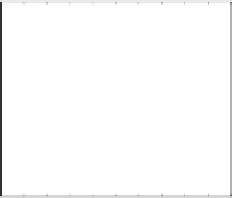Geoscience Reference
In-Depth Information
4
x 10
−3
0
(a)
(b)
4
−50
5
3
2
−100
3
3
2
1
1
6
−150
6
5
1
4
−200
2
0
−250
−500
0
500
−500
0
500
x (km)
x (km)
Fig. 8.2.
The ground mapping of the FLR magnetic field. Panel (
a
) is the amplitude
and panel (
b
) is the phase of the magnetic field. Solid line is a
b
(
g
x
(
x
) (meridional) -
component, dotted line is
b
(
g
y
(
x
) (azimuthal)-component. Lines 1 and 2 refer to the
oscillation period
T
= 20 s, lines 3 and 4
−
T
= 80 s, lines 5 and 6
−
T
= 210 s
and reflected Alfven waves
b
0
with normalization
b
0
δ
i
= 1. For the dayside
ionosphere, the respective amplitude of the incident wave
b
(
i
)
0
≈
b
0
/
2. For the
exp(
imϕ
), the wave numbers
k
y
are
k
y
=
mL
1
/
2
/
(
R
E
+
h
)
where
R
E
= 6370 km. For
L
=2
,
3
,
4, we have
k
y
=1
.
1
perturbations
∝
10
−
3
,1
.
3
10
−
3
×
×
10
−
3
km
−
1
for
m
=6.
The spatial distribution of ground magnetic field calculated according to
(7.51), (7.81) and (7.83) is shown in Fig. 8.2. The panel (
a
) shows the spatial
distribution of amplitudes
b
(
g
x
(
x
)and
b
(
g
y
(
x
), and panel (
b
) - phases. Lines 1
and 2 correspond to
T
= 20 s, lines 3 and 4
and 1
.
5
×
−
T
= 80 s, lines 5 and 6
−
T
=
210 s.
b
(
g
)
is shown by solid lines and
b
(
g
)
is shown by broken lines.
x
y
10
−
3
for
L
= 2, 3, and 4, respectively. Estimates, from (8.26) for the low conductive
ground, are, correspondingly, 3
.
5
10
−
3
,3
.
3
10
−
3
and 3
.
6
Maximum values of the field are 2
.
2
×
×
×
10
−
3
. One can
see that they coincide roughly with the results of the numerical integration.
The maximum of field is shifted relative to the base of the FLR. For
example, the maximum of
b
(
g
x
,
are about
x
=
x
m
=
10
−
3
,3
.
6
10
−
3
and 3
.
4
×
×
×
−
20 km for
T
=20s,
x
m
=
70 km for
T
= 210 s. The half-width
δ
i
found from Fig. 8.2 with (8.26) is correspondingly equal to 10 km (
T
=20s),
47 km (
T
= 80 s) and 77 km (
T
= 210 s).
The
b
(
g
x
(
x
)-phase (Fig. 8.2b) increases with
x
and reaches a maximum
for
x>x
m
.
With further increasing
x,
the phase slowly goes down. The
maximum difference of phases
∆ϕ
= (arg
b
(
g
x
)
max
−
−
50 km for
T
=80sand
x
m
=
−
(arg
b
(
g
x
)
min
is inversely
proportional to
T
. For instance,
∆ϕ
= 175
◦
for
T
=20sand
∆ϕ
= 110
◦
for
T
= 210 s. The ratio of the major to minor axes of the horizontal ellipse of
polarization changes from 2 for
x
= 500 km up to 15 for
x
= 0. Beneath FLR
the polarization becomes almost linear. The sense of rotation of the magnetic
vector can be both the same and opposite on the different sides of FLR. For
example, the sense of rotation changes for oscillations with
T
=20sanddoes
not change for
T
=80s.















Search WWH ::

Custom Search